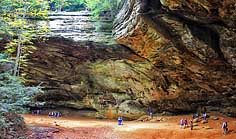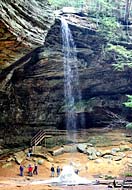|
Scenic USA - Ohio Ash Cave Falls |

| Photos by Gregory S. Hamilton Gregory Hamilton Photography |
Ash Cave, Ohio's largest stone recess cave, stretches 700 feet across and rises 90 feet high.  The horseshoe-shaped rock shelter was created when ground water percolated through the sandstone and eroded away the formation's weaker middle layer, undercutting the resistant top layer which forms the ceiling of the cave. Water continues to dissolve away the cement that holds individual grains together, and seasonal freezing and thawing causes expansion and contraction that further loosens the sand particles.
The horseshoe-shaped rock shelter was created when ground water percolated through the sandstone and eroded away the formation's weaker middle layer, undercutting the resistant top layer which forms the ceiling of the cave. Water continues to dissolve away the cement that holds individual grains together, and seasonal freezing and thawing causes expansion and contraction that further loosens the sand particles.
Archeological excavations during 1877 yielded sticks, arrows, flint artifacts, pottery fragments, corn cobs and animal bones. Further excavations revealed that native inhabitants hunted elk, black bear, deer, turkey, squirrel, rabbit and duck.
Once home to the Wyandot Indians, settlers moved into the area by the 1790s, clearing the area for farming. The massive Ash Cave, recognized for its excellent acoustics, became the site for a variety of public meetings in the 1800s. As late as 1886, the floor of the amphitheater was still covered in ashes.  Artifacts used by early Native Americans indicate the cave was occupied for centuries, one of the most plausible explanations for the ashes found here. Other guesses include the mining of saltpeter nearby, where the process in manufacturing gunpowder includes charcoal. Whichever the case may be, Ash Cave remains today as one of the most popular attractions in Hocking Hills State Park.
Artifacts used by early Native Americans indicate the cave was occupied for centuries, one of the most plausible explanations for the ashes found here. Other guesses include the mining of saltpeter nearby, where the process in manufacturing gunpowder includes charcoal. Whichever the case may be, Ash Cave remains today as one of the most popular attractions in Hocking Hills State Park.
A paved pathway follows a narrow gorge lined with towering eastern hemlocks, making this an easy half mile walk for even the youngest adventurer. Here at the cave a small tributary of the East Fork of Queer Creek creates a thin ribbon that drops a 90 feet into a clear pool below, enticing all photographers to stop and capture this beautiful scene.
Area Map

|
More Area Attractions |
|
Copyright © 2025 Benjamin Prepelka
All Rights Reserved
